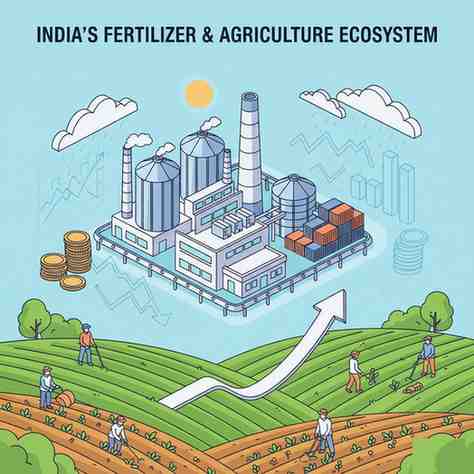
Long-Term vs Short-Term Risks in Indian Fertilizer and Agriculture Stocks
Long-Term vs Short-Term Risks in Indian Fertilizer and Agriculture Stocks
India’s fertilizer and agriculture sectors have long played a critical role in ensuring food security and supporting rural livelihoods. With a growing population, policy interventions, and evolving market dynamics, investors have shown increasing interest in fertilizer company stocks in India. However, the sector’s cyclical nature, regulatory dependencies, and exposure to climatic variations introduce both long-term and short-term risks that investors must evaluate carefully.
Thank you for reading this post, don't forget to subscribe!This article explores these risk dimensions within the broader Indian fertilizer sector outlook, assessing factors influencing stock performance and the sustainability of sectoral growth.
Understanding the Indian Fertilizer and Agriculture Stock Landscape
The Indian fertilizer market is characterized by a mix of government-owned and private manufacturers producing urea, DAP (diammonium phosphate), and complex fertilizers. The agri-input sector performance is closely linked to domestic demand, global commodity prices, and policy frameworks governing subsidies and imports.
The agriculture sector, meanwhile, encompasses not just fertilizers but also agrochemical and seed company stocks, irrigation equipment manufacturers, and firms engaged in sustainable agri-technologies. Together, these segments create a diverse investment ecosystem where cyclical factors, seasonal demand, and policy reforms significantly shape earnings visibility.
Short-Term Market Risks for Agriculture Stocks
Short-term risks in this sector often stem from commodity price volatility in agriculture, climatic disruptions, and policy fluctuations. Among these, monsoon dependency is perhaps the most defining factor influencing quarterly performance. The impact of monsoon on agriculture stocks is evident during years of erratic rainfall, which can directly affect crop yields, rural income, and consequently, fertilizer and pesticide demand.
Another pressing short-term challenge is urea and DAP price fluctuations. As India imports a significant portion of its raw materials, global fertilizer price trends play a decisive role in determining domestic profitability. A spike in international gas or phosphate prices can compress margins for fertilizer producers, particularly when domestic selling prices are controlled or delayed under subsidy frameworks.
Currency movements also contribute to volatility. A depreciating rupee increases the import bill for raw materials, adding near-term pressure on the working capital requirements of manufacturers.
From an investment perspective, these short-term dynamics often translate into uneven quarterly earnings, which can cause price corrections in fertilizer company stocks in India. Hence, investors focusing on short-term gains must closely track seasonal patterns and policy announcements related to subsidy allocations or export restrictions.
Long-Term Growth and Structural Opportunities
While short-term fluctuations are inevitable, the long-term growth in agri stocks in India is supported by several structural drivers. The country’s commitment to improving agricultural productivity and the government’s emphasis on self-sufficiency in fertilizer production are key enablers for steady expansion.
Policy reforms in Indian agriculture, such as rationalizing subsidies, encouraging balanced fertilizer use, and promoting organic and bio-fertilizers, are gradually reshaping sector fundamentals. These initiatives aim to reduce dependency on imports, enhance soil health, and drive sustainable practices.
Moreover, rural demand and farm income growth remain critical long-term catalysts. As rural incomes rise and the adoption of mechanization increases, demand for quality inputs like fertilizers, seeds, and agrochemicals is expected to remain stable. The government’s push toward digital agriculture and precision farming further enhances productivity, thereby creating consistent demand for input providers.
In addition, the shift towards sustainable agriculture investments—including water-efficient fertilizers, green ammonia production, and eco-friendly inputs—presents new opportunities for companies with innovative capabilities and strong R&D frameworks. Such developments are likely to influence the future outlook for Indian agri stocks, as sustainability becomes a key investment theme.
Fertilizer Industry Challenges and Opportunities
The fertilizer industry in India operates within a tightly regulated ecosystem. Government subsidies play a central role in ensuring affordability for farmers but can also create operational challenges for producers due to delayed reimbursements. Understanding the government subsidy impact on the fertilizer sector is essential for evaluating liquidity and profitability trends.
While subsidy dependence remains a constraint, the government has made gradual progress in reforming the system. Direct Benefit Transfer (DBT) mechanisms and policies aimed at reducing urea overuse are steps toward a more efficient and transparent framework.
On the opportunity front, capacity expansions and backward integration initiatives are reshaping the industry. Companies investing in securing raw material sources, diversifying product portfolios, or adopting digital supply-chain solutions are better positioned to manage cost pressures and capture growth. Additionally, fertilizer export and import dynamics are expected to evolve as India seeks to balance domestic needs with export potential in neighboring markets.
The transition toward green fertilizers, renewable feedstocks, and circular manufacturing practices may redefine competitiveness in the long term. These trends align with global moves toward sustainability and could support valuation re-ratings for forward-looking firms.
Balancing Risk and Reward: Investor Considerations
Investors evaluating agriculture stocks investment risks should differentiate between cyclical, policy-driven volatility and structural growth enablers. Short-term risks—such as weather uncertainties, input price hikes, and subsidy delays—may create temporary headwinds. However, the long-term fundamentals of India’s fertilizer and agriculture ecosystem remain intact, supported by policy continuity, food security imperatives, and rising rural consumption.
From a portfolio standpoint, diversification across fertilizer manufacturers, agrochemical companies, and seed producers can mitigate sector-specific risks. Monitoring fertilizer sector profitability trends, along with government budget allocations and international commodity cycles, is crucial for making informed decisions.
Furthermore, climate risk and crop yield impact are increasingly influencing investment strategies. Firms adopting resilient agricultural practices and digital tools to forecast weather patterns may offer more stable long-term returns.
Conclusion
The Indian fertilizer and agriculture sectors present a complex yet compelling investment landscape. While short-term market risks for agriculture stocks arise from policy and climatic uncertainties, the long-term growth in agri stocks in India is underpinned by structural reforms, rising demand, and technological progress.
Understanding both horizons—cyclical challenges and enduring opportunities—is essential for investors seeking to balance risk and reward. As the Indian fertilizer sector outlook continues to evolve, disciplined analysis and selective stock-picking can help investors navigate volatility while participating in the sector’s long-term transformation.
Related Blogs:
Decoding Fertilizer Subsidies: How Government Policy Impacts Your Stocks
Global Gas Prices & Their Ripple Effect on Indian Fertilizer Stocks
The Future of Farming: Are Nano Fertilizers the Next Big Thing for Indian Agriculture Stocks?
Riding the Monsoon: How Seasonal Rains Influence Fertilizer Stock Performance
Best Fertilizer Stocks in India
5 Best Chemical Stocks for Long-Term Investment in India
Top 5 Chemical Stocks in India
Best Chemical Stocks in India
Top 5 Oil and Gas Stocks in India
Renewable Energy Stocks: A Core Component of a Robust 2025 Portfolio
Best Green Energy Stocks in India 2025
Top 5 Fertilizer Stocks in India
Best Fertilizer Stocks in India
Best Pharmaceutical Stocks in India
Disclaimer: This blog post is intended for informational purposes only and should not be considered financial advice. The financial data presented is subject to change over time, and the securities mentioned are examples only and do not constitute investment recommendations. Always conduct thorough research and consult with a qualified financial advisor before making any investment decisions.

